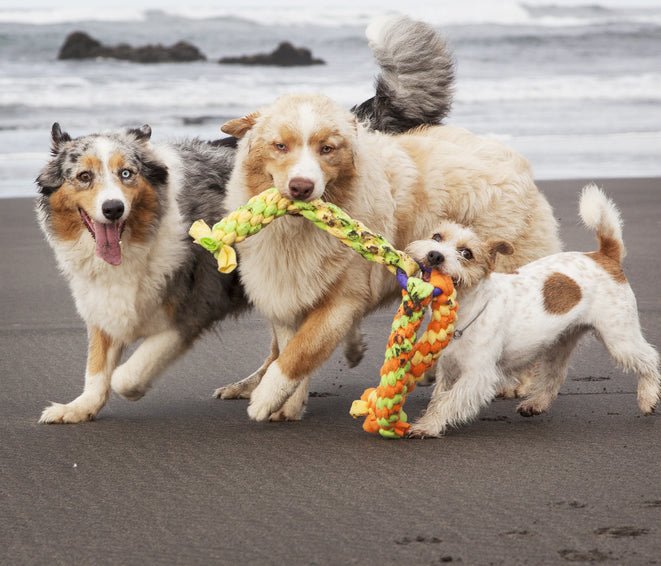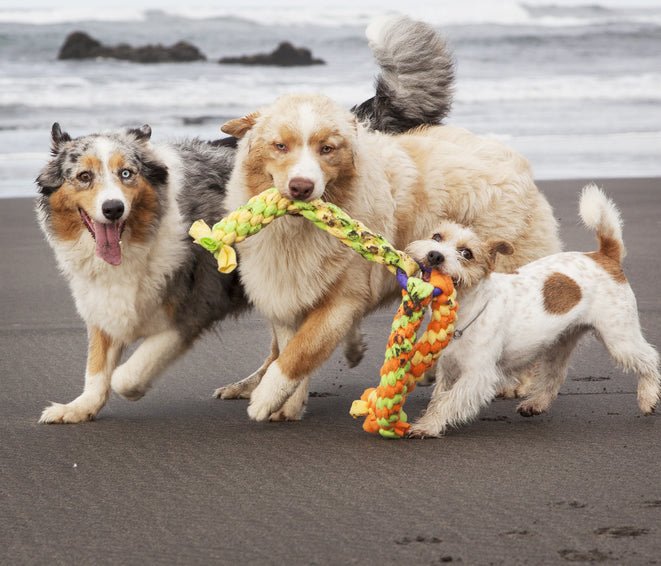Ever wondered why some dog training methods work like magic while others fall flat? The secret lies in understanding two powerful approachesgame-based learning and gamification. The key difference between game-based learning and gamification for dogs is that game-based learning involves using actual games to teach specific behaviors, while gamification adds game elements like rewards and points to traditional training methods. Whether you’re a first-time pet parent or an experienced trainer, mastering these techniques can transform your dog’s learning experience. In this comprehensive guide, we’ll explore how both methods can make training sessions more engaging and effective. Get ready to discover: • How game-based learning naturally taps into your dog’s instincts • Why gamification can boost motivation during training • Practical examples of both approaches in action • Tips to choose the right method for your furry friend Let’s unlock the potential of playful learning to create lasting behavioral changes in your dog.
Understanding Game-Based Learning in Dog Training
Game-based learning has revolutionized the way we approach dog training, making it more engaging and effective. This innovative approach transforms traditional training methods into interactive experiences that naturally motivate dogs to learn and participate.
Core Principles of Game-Based Learning for Dogs
Game-based learning in dog training focuses on creating structured play activities that target specific learning outcomes. Unlike traditional training methods, this approach leverages a dog’s natural instincts and desire to play, making the learning process more enjoyable and sustainable.
When implementing an educational game for dogs, trainers focus on three key elements:
– Clear objectives that define what the dog should learn
– Engaging gameplay that maintains the dog’s interest
– Progressive difficulty levels that build confidence
The beauty of game-based learning lies in its ability to create positive associations with training. Dogs naturally engage with games, making them more receptive to learning new commands and behaviors. This approach also helps reduce training stress and anxiety.
For example, a simple fetch game can be transformed into a powerful educational game by incorporating commands and rewards. As the dog masters basic retrieval, trainers can gradually add complexity by introducing new commands or changing the game rules.
One of the most significant advantages of this method is that it creates a strong bond between dogs and their owners. Through interactive gameplay, dogs learn to associate training sessions with fun and rewards, making them more eager to participate in future learning activities.
Exploring Gamification in Dog Training
The concept of gamification has revolutionized various fields, including dog training. By incorporating game-like mechanics into training sessions, pet owners can make the learning process more engaging and effective for their furry companions.
Elements of Gamified Training
The definition of gamification in dog training involves incorporating playful elements into structured learning activities. This approach transforms routine training sessions into exciting games that keep your dog motivated and focused.
A successful gamification element in dog training includes reward systems, progress tracking, and achievement levels. For instance, you might use a points-based system where your dog earns treats or toys for mastering specific commands. This creates a clear connection between desired behaviors and positive outcomes.
Game-like mechanics such as timed challenges and progressive difficulty levels help maintain your dog’s interest. You might start with simple tasks and gradually increase complexity as your pet masters each level. For example, beginning with basic sit commands before moving to more advanced behaviors like stay or heel.
Creating a structured reward schedule is another vital component. This could involve using different types of treats as rewards for varying difficulty levels, similar to how video games offer different prizes for completing challenges.
Key Differences Between Both Approaches
Motivation and Rewards
When comparing game-based learning and gamification for dog training, they’re truly different animals in terms of how they motivate and reward desired behaviors. Game-based learning naturally taps into your dog’s intrinsic motivation – their innate desire to play, explore, and solve problems. The rewards come from the enjoyment of the activity itself, making learning a naturally engaging process.
On the flip side, gamification is the application of game-like mechanics to regular training sessions. It relies more heavily on external rewards like treats, praise, or toys to encourage participation. While both approaches can be effective, they differ significantly in how they drive engagement and learning outcomes.
Game-based learning creates an immersive environment where your dog learns through play, making the entire experience rewarding in itself. For instance, when teaching fetch, the game itself becomes the learning tool, with the natural joy of running and retrieving serving as the primary motivator.
Gamification, however, adds gaming elements to standard training methods. You might use a point system where your dog earns treats for completing specific tasks, or create achievement levels for mastering different commands. This structured reward system can help maintain interest during repetitive training exercises.
The key distinction lies in how these rewards affect long-term learning. Game-based learning often results in more sustainable behavior changes since dogs associate the activity itself with pleasure. Meanwhile, gamification’s external rewards can be highly effective for initial motivation but may require consistent reinforcement to maintain the desired behaviors.
Types of Training Games for Dogs
Indoor Training Games
Transform your living space into an engaging training arena with indoor games that combine learning and fun. Start with a traditional game like “Find the Treat,” where you hide treats around the house and encourage your dog to use their nose to locate them. This game enhances their scenting abilities while teaching patience and focus.
Create a DIY board game setup using cardboard boxes and cups, placing treats underneath them. This helps develop your dog’s problem-solving skills and mental stimulation. Another effective indoor game is “Follow the Leader,” where you establish yourself as the pack leader and reward your dog for following your movements and commands.
Outdoor Training Activities
Take advantage of open spaces to implement more dynamic training exercises. A serious game like “Recall Racing” helps strengthen your dog’s response to commands while burning excess energy. Start with short distances and gradually increase the challenge as your dog becomes more proficient.
Set up an agility course using natural elements or portable equipment. This combines physical exercise with mental engagement, teaching your dog to follow directions while navigating obstacles. “Hide and Seek” in a safe outdoor area helps reinforce recall commands and builds a stronger bond between you and your pet.
Incorporate fetch variations that include training elements, such as requiring a “sit” or “stay” before throwing the ball. This combines play with obedience training, making the learning process more enjoyable for your furry friend.
Implementing Game-Based Learning for Your Dog
Creating a Safe Learning Environment
When implementing game-based learning (GBL) for your dog, establishing a secure and comfortable environment is crucial for effective training. The GBL environment should be free from distractions and potential hazards that might interfere with your dog’s learning process.
Start by selecting a quiet, enclosed space where your dog feels at ease. This could be a specific room in your house or a fenced backyard. Remove any items that could be dangerous or distracting, such as loose wires, small objects, or other pets.
Consider using soft mats or designated play areas to create a distinct training zone. This helps your dog associate the space with positive learning experiences and formal training sessions. The environment should be large enough for movement-based games but contained enough to maintain focus.
Temperature and lighting also play important roles in creating an optimal learning space. Ensure the area is well-ventilated and comfortably lit. Extreme temperatures or harsh lighting can make your dog uncomfortable and less receptive to learning.
Keep training tools and rewards easily accessible but out of your dog’s immediate reach. This helps maintain a structured environment while allowing you to reward desired behaviors promptly. Consider using a treat pouch or designated container for quick access during training sessions.
Remember to gradually introduce new elements to the training space. This helps prevent overwhelming your dog and allows them to build confidence in the learning environment. As your dog becomes more comfortable, you can slowly add complexity to the games and training exercises.
Setting Up Gamified Training Sessions
Training your dog using gamified methods requires careful setup and monitoring to ensure effectiveness. As a common business practice, professional trainers and instructional designers recommend establishing clear progress tracking systems from the start.
Progress Tracking Methods
Setting up reliable tracking methods helps you monitor your dog’s development and adjust training strategies accordingly. Consider maintaining a digital or physical training journal to record:
– Daily training duration
– Specific commands practiced
– Success rates
– Reward types used
– Behavioral changes
– Areas needing improvement
You can use simple spreadsheets or specialized dog training apps to log these metrics. This systematic approach, often recommended by instructional designers, helps identify patterns in your dog’s learning style and response to different game elements.
Remember to document both successes and challenges. Note which games or activities your dog enjoys most and which ones might need modification. This data becomes invaluable for:
– Adjusting difficulty levels
– Selecting appropriate rewards
– Identifying peak training times
– Planning future sessions
– Measuring long-term progress
Regular review of these tracking methods allows you to celebrate small wins and make informed decisions about advancing to more complex training games.
Best Practices for Both Training Methods
Through a systematic review of game-based training approaches, we’ve identified essential practices that can enhance both gamification and game-based learning for your dog’s development. Let’s explore these proven strategies while avoiding common pitfalls.
Common Mistakes to Avoid
One frequent error is rushing through training sessions without proper planning. Take time to structure your activities, whether you’re using a popular game or implementing reward-based systems. Many pet parents make the mistake of inconsistent reinforcement, which can confuse their dogs and slow down progress.
Another critical error is overcomplicating the training process. Keep exercises simple and gradually increase difficulty as your dog masters each level. Avoid introducing too many new elements simultaneously, as this can overwhelm your furry friend and diminish their enthusiasm for learning.
Remember to maintain a balance between fun and discipline. While making training enjoyable is important, don’t let the entertainment aspect overshadow the learning objectives. Stay focused on your training goals while incorporating playful elements.
Timing is crucial in both methods. Don’t extend training sessions beyond your dog’s attention span, and always end on a positive note. This helps maintain their motivation and ensures they look forward to future training sessions.



